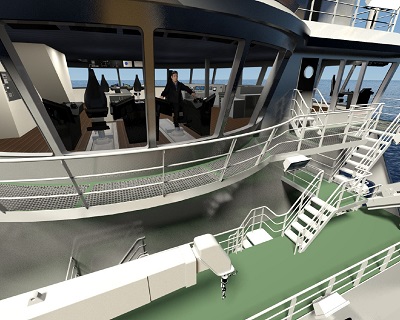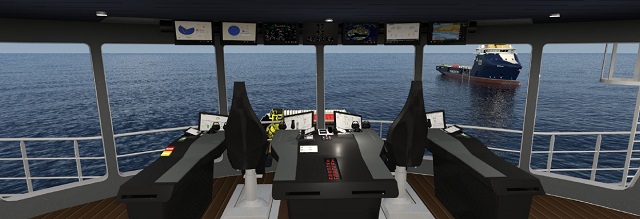All the ?Nice to Have? Bridge Features

A survey of bridge personnel on offshore support vessels found them to be ‘mostly happy’ with their bridge equipment. That wasn’t a good enough answer for Dr. Frøy Birte Bjørneseth, human factors specialist at Rolls-Royce, so the company set out to find a bridge concept that would take account of what respondents considered ‘little luxuries’ or ‘silly details’.
Some of the key findings of the survey were the desire for the flexibility in operating to suit operational preferences, variation in working position, proximity to monitors and controls and the need for an improved view of the aft deck. This led to a three year project in which Bjørneseth and a team of engineers and designers developed a new bridge concept using the resources of the Rolls-Royce human factors laboratory to test equipment and software.
“We undertook studies on board to observe how the crew interacted with the equipment onboard and also spent time with simulators using of state of the art eye tracking equipment so that we could make a very detailed analysis of the interface between operators and their equipment,” she said. “The results subtly but importantly optimize operator comfort and improve their situation awareness.”
When monitoring eye movement, it is actually the pupil that is tracked. “We monitor where the operator rests their eyes (fixates), for how long they fixate on e.g. a particular object and also how much they are scanning the environment. Excessive scanning can indicate that the operator is confused, hence we aim at more precise movements,” said Bjørneseth. “Reducing unnecessary scanning by adjusting the environment so that the user do not have to search for information will leave more mental capacity (less cognitive load) to handle safety critical situations, which can actually mean the difference between incident and accident in many situations.”
Minor adjustments can have great impact. One example is the placement of displays. Just a few centimetres can be the difference between operating in a relaxed position where the operator leans on the chair's backrest versus that where the operator has to lean forward numerous times to touch a display that is just out of reach. This causes annoyance and strain and increases cognitive load.
 As a result of the project, both the physical and graphical interfaces of the Rolls-Royce unified bridge systems have been improved to ensure low reflection of sunlight during day operations, and a common dimming philosophy has been used to ensure good night time vision. Easy access and exit from workstations together with spacious passages between windows and workstations has been emphasized.
As a result of the project, both the physical and graphical interfaces of the Rolls-Royce unified bridge systems have been improved to ensure low reflection of sunlight during day operations, and a common dimming philosophy has been used to ensure good night time vision. Easy access and exit from workstations together with spacious passages between windows and workstations has been emphasized.
The front end of the consoles has been angled so that the operator can have an even better ergonomic position during operation. The wrist is kept in a relaxed position while the hand operates levers. This is especially important during winch and anchor handling operations, says Bjørneseth. “This type of operation requires hours of static muscular activity as there is no possibility for driving the system automatically when, for example, the operator is required to release wires to lower anchors.”
Displays have been moved so that they do not obstruct the operator’s deck view. Large displays have been increased from 19 to 24 inches and brought into reach. Levers and emergency switches have been placed in easily recognizable positions.
Bridge chairs have been made flexible enough to support both seated and standing operation and are designed to better enable the operator to vary their posture. It is now easier to move and turn in the chair, as it was found that operators tended to turn their torso to look behind rather than moving the chair.
All the modifications have been incorporated in Rolls-Royce’s common look and feel for both hardware and software user interfaces and are already being delivered to customers such as Simon Møkster Shipping.
“The Rolls-Royce Unified Bridge can be used for all vessel types, not only platform supply vessels. It is a modular concept that can be combined in many different ways to suit the customer's requirements. It is however the holistic bridge experience (consoles, levers, displays, software) and not only the consoles themselves that makes for the good user experience,” said Bjørneseth.

